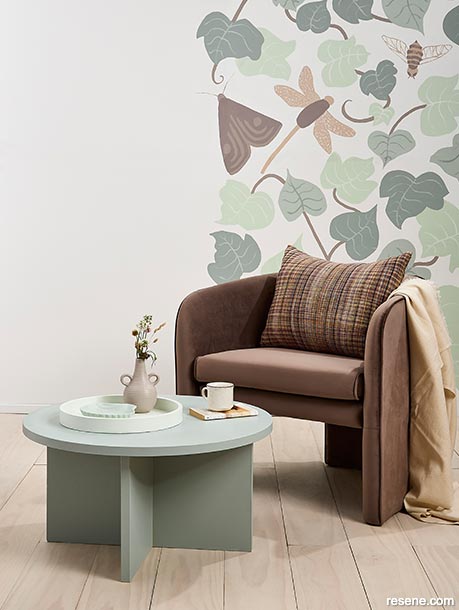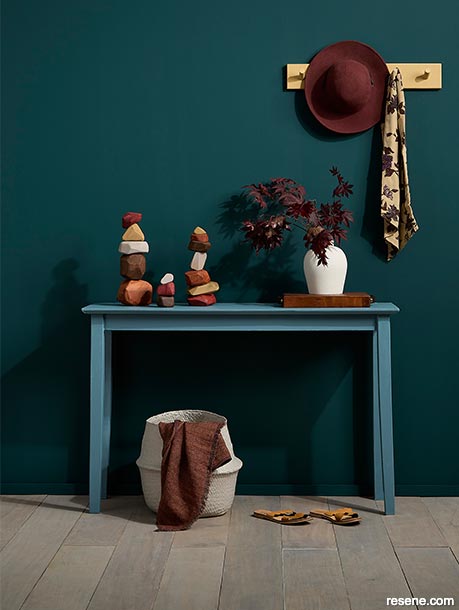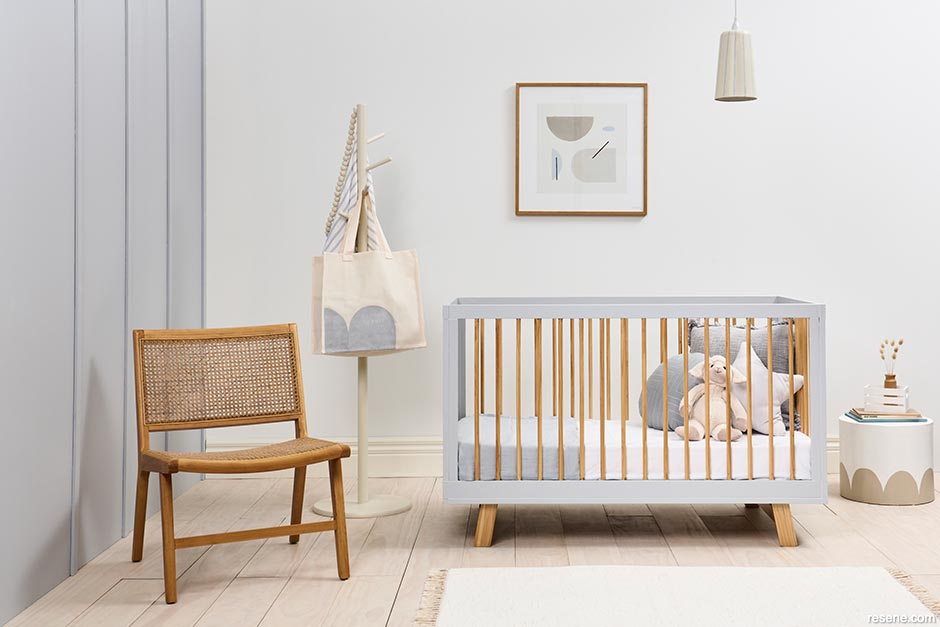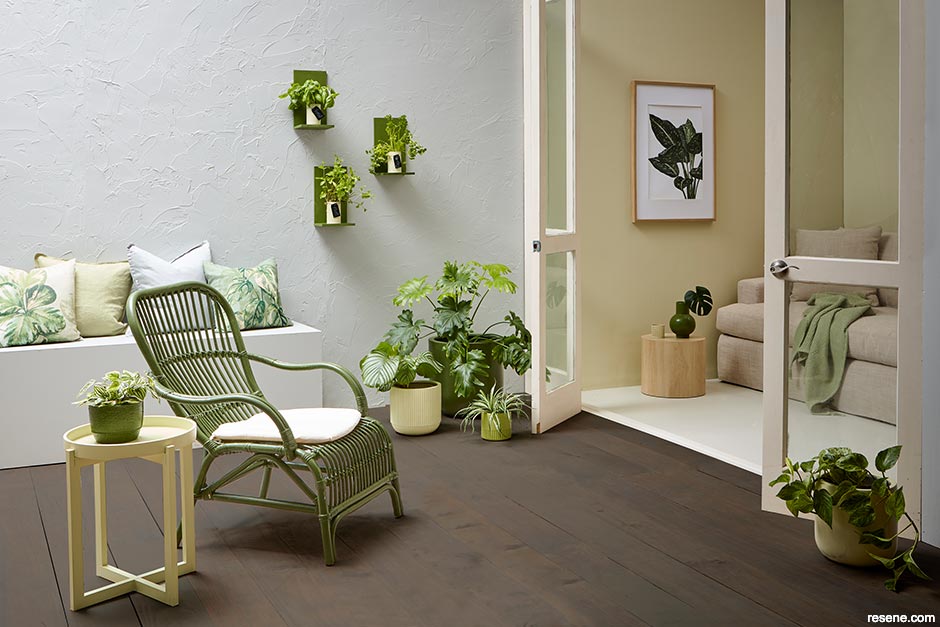From the Resene decorating blog
Let’s take a look at what’s new in environmentally friendly design and decorating.
There has been a huge recent shift toward biophilic design when it comes to modern interiors. We are increasingly embracing nature and a connection to the outdoors in the colours and designs we choose.

Resene Room Velvet painted on the walls of this lounge is part of Resene’s range of plant-based paints.
Walls painted in Resene Eighth Rice Cake (background), with designs in Resene Edward, Resene Rainee, Resene Kandinsky, Resene Cashmere, Resene Zorba, Resene Tom Tom and Resene Willow Brook. Coffee table painted in Resene Edward, tray in Resene Willow Brook, dish in Resene Rainee, vase in Resene Zorba and floor in Resene Colorwood Breathe Easy. Cushion and throw from Citta, chair from Danske Møbler. Project by Shani Luckman, image by Bryce Carleton.

If you have leftover paint from a renovation, you may be able to use it in creative projects around the house or consider checking with a local charity to see if they have a use for it.
Wall painted in Resene Welcome, console painted in Resene Streetwise, wall hook painted in Resene Papier Mache, vase painted in Resene Half Tea, board underneath vase painted in Resene Colorwood in Walnut, basket painted in Resene Settlement, rocks painted in Resene Woodsman in Resene Japanese Maple, Resene Warm Kwila, Resene Riverstone, Resene Driftwood and Resene Bark. Throw from Citta. Project by Shani Luckman, image by Bryce Carleton.
But, ironically, sometimes we don’t always pay close attention to how kind to nature the design and renovation products and services we use are.
Let’s take a look at what’s new in environmentally friendly design and decorating.
As Ashleigh Strange, of Resene’s advice team says, sustainable and eco-friendly decorating is not just about choosing an Environmental Choice-approved paint, it is also about making sure that paint is applied in an environmentally responsible way.
Environmental Choice NZ is now known as Eco Choice Aotearoa. It is New Zealand’s official eco-label offering strong independent proof of environmental best practice for those products and services that bear the label.
Resene has been committed to producing environmentally preferable paint products since just after the company launched in the 1950s. The company proactively removed lead from its products, developed a wide range of waterborne products to reduce the level of toxic solvents, and joined the Environmental Choice NZ programme back in the 1990s. Resene continues to provide the widest range of Environmental Choice NZ/Eco Choice Aotearoa approved paints today.
Having joined Eco Choice Aotearoa, Resene then set about removing almost all odorous material from Resene Zylone Sheen and Resene Ceiling Paint, giving users high quality products without the unwanted odours. For those who prefer no added VOC options, Resene Zylone Sheen Zero comes in a wide range of colours with no added VOCs.
There are so many catchwords and labels out there, identifying paints, stains and other home renovation products as environmentally friendly in different ways, that looking out for the Eco Choice Aotearoa label is a good place to start, Ashleigh says.

Another good place to start planning for environmentally friendly renovations, whether it is a simple re-paint, or a full construction project is to have a plan for waste.
It’s also a good idea to have a sound plan for the project itself, no matter how big or small, because that should help you avoid mistakes that create additional waste. Even if you’re just painting a small room, take the time to measure the area so you can accurately measure how much paint you will need. Resene has a handy online paint calculator that can help with this.
Avoid waste by storing your paint correctly. When you’re finished, cover the top of the paint container with plastic wrap and place the lid on securely. Some decorators prefer to store it upside down so the paint will create a tight seal around the lid to keep it fresher for when you next wish to use it. Store away from extreme heat or cold. Keep out of reach of children.
If you do have paint left over that you don’t think you will use for touch ups or other projects, you could contact local charities or schools to see if they can use it for their own projects. You can also take unwanted paint and paint containers into selected Resene ColorShops which have been designated as Resene PaintWise collection centres. They can also recycle packaging materials that are recyclable and send solventborne paints to solvent recovery.

When dropping off paint and paint containers:
If you are doing most of your renovation work yourself, do some research on waste services in your local area that may help you dispose of different materials, such as wood, plasterboard, old wallpaper, roofing iron and insulation. Often materials in good condition will be snapped up by another home decorator in your local area through platforms like Facebook, or you may even find a new use for them yourself. There are also companies around who specialise in the removal of construction waste, and you may even be able to sell some things to salvage and demolition yards.
If you are using a builder or painter to help complete your project, ask them how they dispose of materials. You can also work with a Resene Eco.Decorator, which is a network of painting contractors who have undergone assessment of their environmental practices, such as sustainable work practices, waste management, project plans and project sign off processes.
Only contractors who meet the standards can become part of the Resene Eco.Decorator programme, which includes ongoing monitoring to ensure those standards are met.
Top tip: Wrap your brush in plastic wrap or place your roller in a plastic bag, squeeze out the air and tie the bag securely around the handle of the roller with a rubber band or twist tie. This will keep the paint fresh while you’re taking a break and save you having to rinse out brushes and rollers repeatedly, reducing wastewater.
It might come as a surprise to many to know that not all paints are vegan. Traditionally some different types of paint have contained animal products such as beeswax or tallow, but today choosing a vegan paint is actually fairly straightforward, thanks to the development of new hybrid waterborne alkyd polymers based on plant oils such as linseed and castor oil, rather than fossil hydrocarbons.
Resene’s new range of plant-based hybrid waterborne alkyds are Eco Choice Aotearoa approved and include products like Resene Velvet Low Sheen, Resene Waterborne Lusta-Glo and Resene Woodsman Decking Oil Stain.
Top tip: If you are committed to not using animal products be sure to also ask for synthetic brushes and rollers.
Did you know… Resene EarthSense Ceiling Paint is made from renewable raw materials. The recycled pail Resene Ceiling Paint comes in is another environmental innovation, made from 100% recycled material. It is the first commercial paint pail in New Zealand that utilises material from old paint pails to manufacture a new paint pail.
The most important thing you can do to minimise your decorating on the environment is to make sure you use the product that is best suited your project to ensure that you are protecting the surface well. Much like suntan lotion, paint is designed to protect the surface it goes over, as well as making it look better. It is much harder and creates more waste having to replace the cladding or interior lining than refreshing the paint. It’s best to choose quality paint that will keep your surface in the best condition possible to keep your project in good shape.



May 02, 2023
Visit your Resene ColorShop or use the free Resene Ask a Paint Expert service, to find the best paint or wood stain options for your project.
Book a colour consult | Ask a Colour Expert | Ask a Paint Expert
Resene's decorating blog
Paint your home beautiful! Discover the latest decorating trends, tips and colour news.
![]()
Previous «
Subtle sparkle
![]()
Blog home
View the latest trends, tips and news
![]()
» Next
From Miami to Cuba – timeless tropical brights